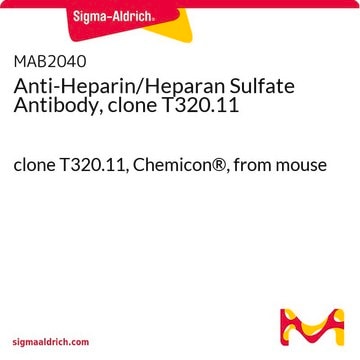MAB1948P
Anti-Heparan Sulfate Proteoglycan (Perlecan) Antibody, clone A7L6
clone A7L6, from rat
Sinonimo/i:
heparan sulfate proteoglycan 2, Schwartz-Jampel syndrome 1 (chondrodystrophic myotonia), endorepellin (domain V region), perlecan proteoglycan, heparan sulfate proteoglycan of basement membrane
About This Item
Prodotti consigliati
Origine biologica
rat
Livello qualitativo
Forma dell’anticorpo
purified antibody
Tipo di anticorpo
primary antibodies
Clone
A7L6, monoclonal
Reattività contro le specie
human
tecniche
immunocytochemistry: suitable
immunohistochemistry: suitable
immunoprecipitation (IP): suitable
western blot: suitable
Isotipo
IgG2aκ
N° accesso NCBI
N° accesso UniProt
Condizioni di spedizione
wet ice
modifica post-traduzionali bersaglio
unmodified
Informazioni sul gene
human ... HSPG2(3339)
Descrizione generale
Clone A7L6 recognizes domain IV of the core protein of the large heparan sulphate proteoglycan or perlecan. The reactivity is independent of the galactosaminoglycan moieties; therefore, the epitope is not sensitive to heparinase treatment.
Specificità
Immunogeno
Applicazioni
A previous lot was used in independent laboratories in WB.
un lotto rappresentativo è stato usato da un laboratorio indipendente in IP. (Couchman, 1989).
Struttura cellulare
Proteine dell′ECM
Qualità
Analisi immunocitochimica: 1:500 dilution of this antibody detected Heparan Sulfate Proteoglycan in HeLa and A431 cells.
Linkage
Stato fisico
Stoccaggio e stabilità
Risultati analitici
Altre note
Esclusione di responsabilità
Not finding the right product?
Try our Motore di ricerca dei prodotti.
Codice della classe di stoccaggio
12 - Non Combustible Liquids
Classe di pericolosità dell'acqua (WGK)
WGK 1
Punto d’infiammabilità (°F)
Not applicable
Punto d’infiammabilità (°C)
Not applicable
Certificati d'analisi (COA)
Cerca il Certificati d'analisi (COA) digitando il numero di lotto/batch corrispondente. I numeri di lotto o di batch sono stampati sull'etichetta dei prodotti dopo la parola ‘Lotto’ o ‘Batch’.
Possiedi già questo prodotto?
I documenti relativi ai prodotti acquistati recentemente sono disponibili nell’Archivio dei documenti.
Il team dei nostri ricercatori vanta grande esperienza in tutte le aree della ricerca quali Life Science, scienza dei materiali, sintesi chimica, cromatografia, discipline analitiche, ecc..
Contatta l'Assistenza Tecnica.








